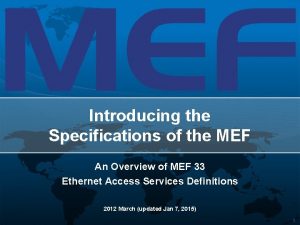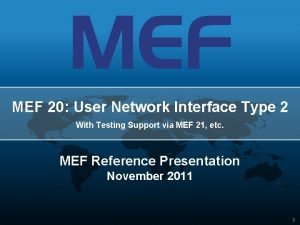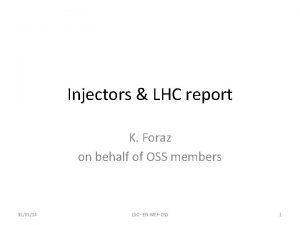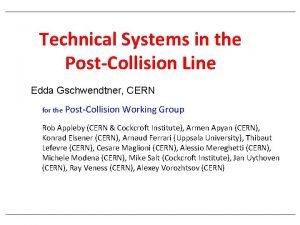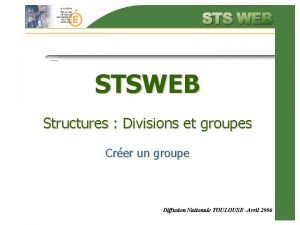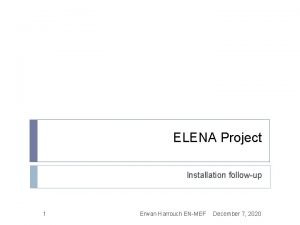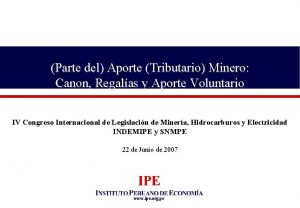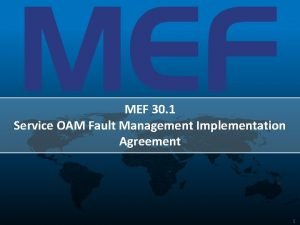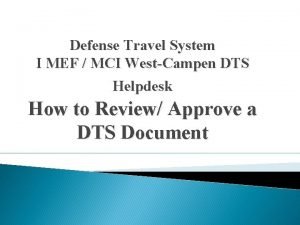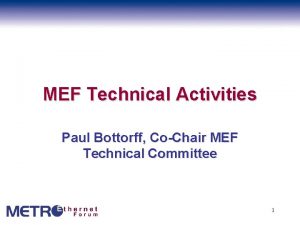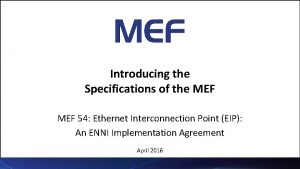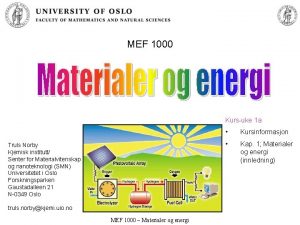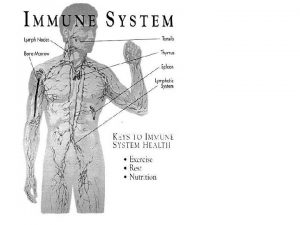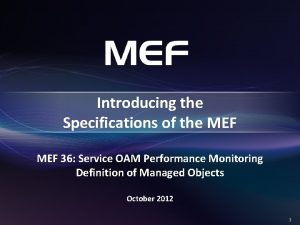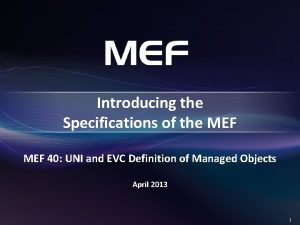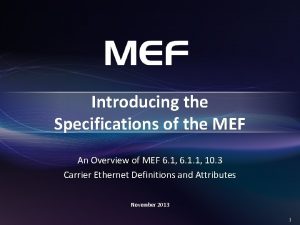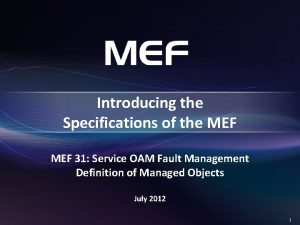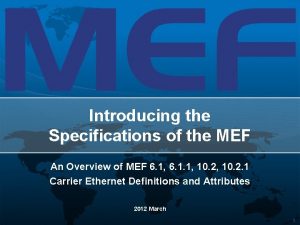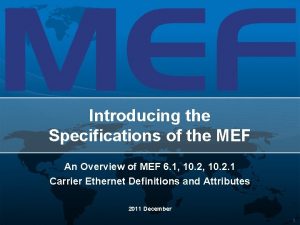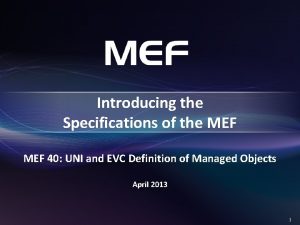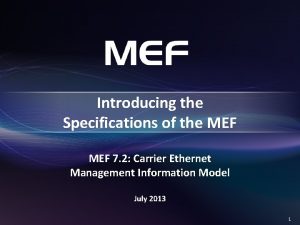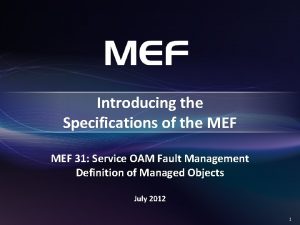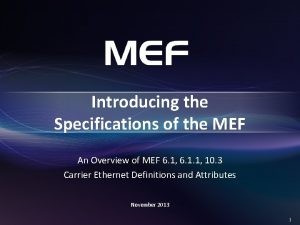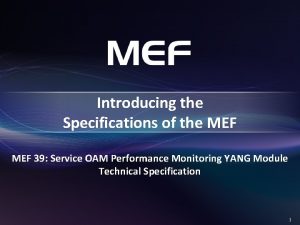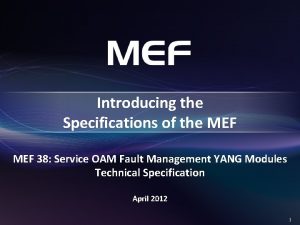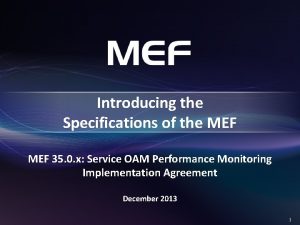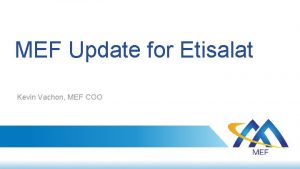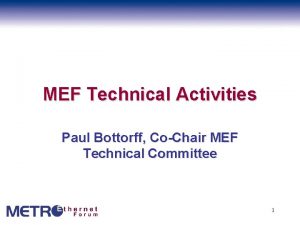Introducing the Specifications of the MEF 22 1




































- Slides: 36

Introducing the Specifications of the MEF 22. 1. 1: Mobile Backhaul Phase 2 Amendment 1 - Small Cells 1

MEF Reference Presentations • Intention – These MEF reference presentations are intended to give general overviews of the MEF work and have been approved by the MEF Marketing Committee – Further details on the topic are to be found in related specifications, technical overviews, white papers in the MEF public site Information Center: http: //metroethernetforum. org/Information. Center Notice © The Metro Ethernet Forum 2015. Any reproduction of this document, or any portion thereof, shall contain the following statement: "Reproduced with permission of the Metro Ethernet Forum. " No user of this document is authorized to modify any of the information contained herein. 2

Topics • • Approved MEF Specifications Introduction Small Cell Background MEF On-Going Work Small Cell Radio Coordination MEF 22. 1. 1 amendment Summary 3

Approved MEF Specifications* Specification Description MEF 2 Requirements and Framework for Ethernet Service Protection MEF 3 Circuit Emulation Service Definitions, Framework and Requirements in Metro Ethernet Networks MEF 4 Metro Ethernet Network Architecture Framework Part 1: Generic Framework MEF 6. 1 Metro Ethernet Services Definitions Phase 2 MEF 7. 1 EMS-NMS Information Model Phase 2 MEF 8 Implementation Agreement for the Emulation of PDH Circuits over Metro Ethernet Networks MEF 9 Abstract Test Suite for Ethernet Services at the UNI MEF 10. 2 Ethernet Services Attributes Phase 2 MEF 11 User Network Interface (UNI) Requirements and Framework MEF 12. 1 Metro Ethernet Network Architecture Framework Part 2: Ethernet Services Layer MEF 13 User Network Interface (UNI) Type 1 Implementation Agreement MEF 14 Abstract Test Suite for Traffic Management Phase 1 MEF 15 Requirements for Management of Metro Ethernet Phase 1 Network Elements MEF 16 Ethernet Local Management Interface *Current at time of publication. See MEF web site for official current list, minor updates and superseded work (such as MEF 1 and MEF 5) 4

Approved MEF Specifications Specification Description MEF 17 Service OAM Framework and Requirements MEF 18 Abstract Test Suite for Circuit Emulation Services MEF 19 Abstract Test Suite for UNI Type 1 MEF 20 User Network Interface (UNI) Type 2 Implementation Agreement MEF 21 Abstract Test Suite for UNI Type 2 Part 1: Link OAM MEF 22. 1 Mobile Backhaul Implementation Agreement Phase 2 MEF 22. 1. 1 Amendment to MEF 22. 1 – Small Cell Backhaul MEF 23. 1 Class of Service Implementation Agreement Phase 2 MEF 24 Abstract Test Suite for UNI Type 2 Part 2: E-LMI MEF 25 Abstract Test Suite for UNI Type 2 Part 3: Service OAM MEF 26. 1 External Network Interface (ENNI) – Phase 2 MEF 27 Abstract Test Suite For UNI Type 2 Part 5: Enhanced UNI Attributes & Part 6: L 2 CP Handling MEF 28 External Network Interface (ENNI) Support for UNI Tunnel Access and Virtual UNI MEF 29 Ethernet Services Constructs 5

Approved MEF Specifications Specification Description MEF 30 Service OAM Fault Management Implementation Agreement MEF 31 Service OAM Fault Management Definition of Managed Objects MEF 32 Requirements for Service Protection Across External Interfaces MEF 33 Ethernet Access Services Definition MEF 34 Abstract Test Suite for Ethernet Access Services MEF 35 Service OAM Performance Monitoring Implementation Agreement MEF 36 Service OAM SNMP MIB for Performance Monitoring MEF 37 Abstract Test Suite for ENNI MEF 38 Service OAM Fault Management YANG Modules Technical Specification MEF 39 Service OAM Performance Monitoring YANG Modules Technical Specifications MEF 40 UNI and EVC Definition of Managed Objects Technical Specification MEF 41 Generic Token Bucket Algorithm Technical Specification MEF 42 ENNI and OVC Definition of Managed Objects Technical Specification MEF 43 Virtual NID (v. NID) Functionality for E-Access Services Technical Specification MEF 44 Virtual NID (v. NID) Definition of Managed Objects Technical Specification MEF 45 Multi-CEN L 2 CP Technical Specification 6

Approved MEF Specifications Specification Description MEF 46 Latching Loopback Protocol and Functionality Technical Specification MEF 47 Carrier Ethernet Services for Cloud Implementation Agreement MEF 48 Service Activation Testing Technical Specification MEF 49 Service Activation Testing Control Protocol and PDU Formats Technical Specification MEF 50 Carrier Ethernet Service Lifecycle Process Model Guidelines Document 7

This Overview Presentation • Purpose: – This presentation is an introduction to MEF 22. 1. 1 • Scope of the Amendment – Mobile backhaul and midhaul, for macro and small cells, for mobile technologies • Audience – Equipment manufacturers building devices that will carry mobile backhaul traffic over Carrier Ethernet – Useful for mobile backhaul service providers architecting their systems for Carrier Ethernet – For wire-line service providers architecting their systems for the inclusion of mobile backhaul traffic over Carrier Ethernet 8

MEF 22. 1. 1 and Relationship to other SDOs MEF 6. 1 MEF 10. 2 MEF 13 MEF 23. 1 MEFs own work as the foundation Other SDOs TR. 221 Industry trends 3 G to 4 G/LTE MEF 22. 1. 1 Capacity/ Coverage Standardized reference points Service Requirements (Service Types, Co. S, Eth OAM, etc) Synchronization Recommendations Small Cells Amendment 9

MEF Mobile Backhaul: Work in Progress • MEF-22. 2 – Mobile backhaul across multiple service providers’ networks using ENNI/OVC based services – Alignment with MEF 6. 2 & MEF 10. 3 • MEF-22. 2. 1 – Time/Phase Synchronization support 10

Small Cell Background 11

End User Experience Challenges Data rate 1 3 2 1. Increase overall cell site performance 2. Increase cell edge data rates 3. Increase indoor data rates 12

Increase Capacity & Coverage Data rate 1 3 2 3 3 ’Super-macro’ Micro & Pico 1. ”Super-macro” – advanced antennas, spectrum aggregation 2. Macro densification 3. Small cells – Micro & Pico 13

Increasing Network Capacity with Small Cells Macro Cell Small Cell Network Transformation Target capacity per cell 100 to 300 Mbps 25 to 100 Mbps 1 5 to 25 100 to 300 Mbps 125 Mbps to 2. 5 Gbps Indoor coverage Poor Good Impact of SON / coordination Low High Cell density relative to macrocell Total capacity Small cells are best to meet the demand challenge 14

Heterogeneous Network Improved macros ed r i qu city e R apa C nt y e rr cit u C apa C Macro densification Small cells 15

Heterogeneous Network Deployment Small Cells advantage is greater in Metropolitan Areas Area traffic density but also in other areas to increase coverage and/or capacity Improved macros Macro densification Small cells Improved macros Macro densification Improved macros Dense urban Urban Suburban Rural 16

Small Cell Coordination 17

Small Cells & Radio Coordination • To improve uplink coverage – i. e. cell edge throughput • To increase capacity – Capacity improves as coverage improves • Offload congested macro cells • Why is Radio coordination needed? – Interference coordination between macro and small cells will Boost coverage and capacity Small cells improves coverage and capacity 18

What is Coordination? • Multiple schemes and possibilities, often used in combination – – Coordinated scheduling Coordinated beamforming (null forming) Dynamic point selection Joint transmission/reception Macro (high power) Best downlink Best uplink Small cell (low power) Best downlink Best uplink 19

What is Co. MP? • Coordinated Multi. Point • Multiple schemes and possibilities, often used in combination – – – Coordinated scheduling Coordinated beamforming (null forming) Dynamic point selection Joint transmission/reception … different resources scheduled Null forming 20

Where are the Co. MP gains? The majority of the uplink/downlink bandwidth gain is on the cell edge between the small cell and the macro it shares a footprint with No Co. MP Gain Co. MP Bandwidth Gain: Uplink ~30 -50%, Downlink ~15% Co. MP Bandwidth Gain: Uplink ~50 -100%, Downlink ~30% 21

Different Degrees of Macro Cell Coordination › No coordination – Example: uncoordinated deployment with femto cell in a macro network › Moderate coordination – Example: Coordinated deployment of pico cell in a macro network using range expansion or e. ICIC (enhanced Inter-Cell Interference Coordination) › Tight coordination – Example: Coordinated deployment of pico cell in a macro network using features such as coordinated scheduling › Very tight coordination – Example: DU/RU radio network using features such as joint scheduling (air interface) over CPRI (Common Public Radio Interface) 22

e. ICIC - Moderate Coordination › Macro cell avoids scheduling in “protected” subframes – Capacity loss in macro layer and pico layer – Reduced interference from macro cell in “protected” subframes › Advanced Rx in Ue required for range expansion › Cell size: Dense urban environment › Time alignment: +/- 5 us required between macro and small cell › Latency: No special demands › Bandwidth Needs: Low Unprotected subframes Protected subframes UEs in macro cell scheduled in non-protected subframes only UEs in range expansion zone scheduled in protected subframes only UEs in inner part of pico cell scheduled in any subframe Time alignment is needed 23

DL Coordination Scheduling - Tight Coordination › Down Link › Share information. › Based on received information, perform coordinated scheduling › Cell size: Dense urban environment › Time alignment: +/-1. 5 us required between macro and small cell › Latency: 1. . 10 ms – the lower the latency, the better the cell edge gain › Bandwidth: Up to 20 Mbps, per coordinated cell pair Coordinating link Time alignment and low latency is needed 24

UL Joint Reception - Very Tight Coordination Radio Unit › Up Link - Schedule UEs. S 1 CPRI › Receive transmitted data. › Share received data and jointly process it /X 2 CPRI Common baseband (Communicate back ACK/NACK to BS responsible to certain UE. ) › Cell size: Dense urban environment › Time alignment: +/-1. 5 us required between cells › Latency: <0. 5 ms one way › Bandwidth: 1 Gbps per antenna, TIME ALIGNMENT, HIGH BW & VERY LOW LATENCY => BASEBAND INTERNAL ONLY internal RBS interface Time alignment, high bandwidth &very low latency is needed 25

MEF 22. 1. 1 - Small Cells 26

Introduction to the Amendment • The MEF 22. 1. 1 amendment makes the following changes to MEF 22. 1: 1. Backhaul, Midhaul and Fronthaul are defined 2. Small Cells, along with heterogeneous networks and radio coordination, are introduced 3. New variations of existing use cases 4. new use case 3 is defined for the midhaul case 5. CPOs for small cells with tight radio coordination are described 6. CPOs for small cells with split bearer are described 7. A new Appendix defines the Aggregation Node 8. A new Appendix summarizes LTE radio coordination 27

MEF 22. 1. 1 – New Terminology Remote radio site Basstation site Fronthaul Network controller / gateway site Backhaul SGW, MME RRU Marco RBS Midhaul Backhaul Small cell site Backhaul – macro/small cell to core Midhaul – small cell to macro Fronthaul – remote radio to baseband unit Small RBS 28

Small Cell alternatives Distributed Baseband Architecture Common Baseband Architecture - Backhaul – macro or small cell BS to core – Backhaul – macro BS to core – Fronthaul - CPRI interconnect between remote radio units and baseband unit - Midhaul – small cell to macro X 2 / S 1 Small RBS S 1/X 2 Small RBS m. RRU I R CP CPR m. RRU I Small cells are operator-controlled, low-powered radio access nodes, which typically have a range from 10 metres to several hundred metres. They may be a complete basestation (distributed as on the left) or just the radio/antenna (common as on the right) 29

Generalized BS aggregation RAN BS site CSAG may be used by the mobile operator to aggregate backhaul traffic before the MEF UNI. The aggregation may be L 2 or L 3 LTE GSM LTE CDMA CEN UNI CSAG UNI-C EVC UNI-N UNI-C Small cell site Legend CSAG- Cell Site Aggregation Gateway Mobile Operator A LTE Mobile Operator B 30

CEN and non-CEN hybrid MEF MBH can be part of a multi-technology end-to-end backhaul Mobile Network RAN BS site CEN UNI UNI-C RAN CE UNI-N EVC Mobile Network RAN NC site UNI-N Non-MEF service UNI-C e. g. , IP UNI UNI-N EVC UNI-N UNI-C RAN CE 31

Backhaul with Small Cell Extension Use Cases LTE S 1 Backhaul: Small Cell RAN BS site Mobile Network RAN BS site CEN UNI-C EVC(s) UNI-N CEN UNI-C UNI EVC(m) UNI-N UNI-C S 1 RAN CE Mobile Network RAN NC site Midhaul RAN CE Backhaul LTE S 1 & X 2 Backhaul: Small Cell RAN BS site CEN UNI-C RAN CE Mobile Network RAN BS site EVC(s) UNI-N X 2 Midhaul CEN UNI-C RAN CE Mobile Network RAN NC site UNI EVC(m) UNI-N S 1 UNI-C RAN CE Backhaul 32

Backhaul with Small Cell Extension Use Cases (2) LTE-A Dual Connectivity : Small Cell RAN BS site CEN UNI-C RAN CE Mobile Network RAN BS site EVC(s) UNI-N X 2+ CEN UNI-C Mobile Network RAN NC site UNI-C UNI EVC(m) UNI-N UNI-C S 1 RAN CE Backhaul Midhaul CPRI & Backhaul: Small Cell RRU site Fibre or DWDM Mobile Network RAN BS site CEN UNI CPRI UNI-C RAN CE Fronthaul Mobile Network RAN NC site UNI EVC(m) UNI-N S 1 UNI-C RAN CE Backhaul 33

Transport Requirements › Backhaul – Macro – Core (e. NB – EPC) – Packet based Latency ~20 ms › Fronthaul – Baseband – Radio Unit (Main-Remote) – Dedicated Fibre Latency ~50 us Latency ~20 ms › Midhaul – Macro – small cell (e. NB-e. NB) – Options › Same as backhaul › Support tight coordination › Support X 2+ Latency ~1 ms Latency ~50 ms 34

New CPO for tight coordination Constrained PT 1 : FD of 1 ms (Co. S Name H) – 10 ms (Co. S Name L) E 2 E budget example for S 1: 1+5+1+20=27 ms for Co. S Name M Node – 1 ms PT 1 C M – 5 ms Site – 1 ms PT 1 M – 20 ms 35

Summary • The need for greater capacity, indoor penetration and spectralreuse is driving the requirement for small cell solutions • Small cell networks present their own unique deployment and backhaul challenges • MEF-22. 1. 1 will cover Small cell with tight coordination backhaul and is backwards compatible with MEF-22. 1 36
 Mef specifications
Mef specifications Mef 20
Mef 20 Mef
Mef Mef ee
Mef ee Edda gschwendtner
Edda gschwendtner Stsweb
Stsweb Monteduro mef
Monteduro mef Mef
Mef Francesca romagnoli mef
Francesca romagnoli mef Snmpe
Snmpe Mef17 agenda
Mef17 agenda I mef help desk
I mef help desk Mef
Mef Mei=mef
Mei=mef Mef eline testing
Mef eline testing Enni vs nni
Enni vs nni Sdn nfv certification
Sdn nfv certification Mef
Mef Mef23
Mef23 Truls norby
Truls norby Introducing and naming new products and brand extensions
Introducing and naming new products and brand extensions Adobe illustrator cs
Adobe illustrator cs Introducing rhetoric using the available means
Introducing rhetoric using the available means Introducing neeta anil said
Introducing neeta anil said Mla format quotes
Mla format quotes Quote analysis starters
Quote analysis starters Introduce yourself
Introduce yourself Int family
Int family Introducing flex pods
Introducing flex pods Khdmdcm
Khdmdcm Introduction to kfc
Introduction to kfc Introducing family members in french
Introducing family members in french Ariel introducing a
Ariel introducing a Different signal phrases
Different signal phrases An organism develops active immunity as a result of
An organism develops active immunity as a result of Templates for introducing quotations
Templates for introducing quotations An introduction to the odyssey
An introduction to the odyssey
